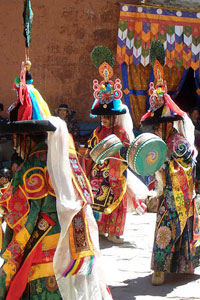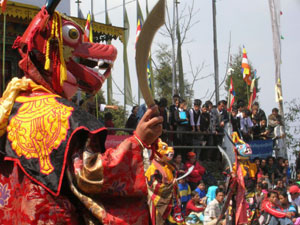|
|
|
Sikkim
Festivals |
|
|
|
The fairs and festivals in Sikkim are
celebrated according to Buddhist calendar. During these
festivals the people of Sikkim perform colorful dance and
music. Chaam is one of the most interesting form of ritual
dance of the Lamas, which feature colorful masks and charming
musical instruments and are held at various monasteries during
the festivals. Costumed Lamas with gaily painted masks,
ceremonial swords and sparkling jewels, leap and swing to the
rhythm of drums, horns and music. Some of the festivals which
are celebrated in Sikkim are Losoong, Bumchu, Saga Dawa and
Phang Lhabsol. |
|
|
|
Saga
Dawa
Saga Dawa is the triple blessed festival. This festival
is considered as one of the holiest Buddhist festival
for the Mahayana Buddhists. On this day the people visit
monasteries and worship and offer butter lamps. Three
important events connected to the life of Buddha are
celebrated in this festival. These events are the Birth
of Lord Buddha, Enlightenment taken by Lord Buddha and
death of Lord Buddha or attaining Nirvana. This festival
is celebrated on the full moon day of the 4th month of
Buddhist lunar calendar around the end of May and early
June. This festival is celebrated in Gangtok. On this
day the monks carry the Holy Books of the Lord Buddha
from the Tsuk-La-Khang monastery around the town in a
large procession.
Drupka Teshi
Drukpa Teshi festival is celebrated by the Buddhists.
This festival is celebrated as on this day the Buddha
preached his first sermon of four Noble Truths to his
five disciples at a deer park in Sarnath. The first
Noble Truth is the Noble Truth of suffering. The Second
Noble Truth is |
 |
|
|
the truth of
the origin of suffering Karma and Delusion and their causes.
The third Noble Truth is the cessation of the suffering or the
attainment of Nirvana. The fourth Noble Truth is the truth of
the Eight Fold Path leading to Nirvana. This day is celebrated
on the fourth day (Teshi) of the sixth month (Drukpa) of the
Tibetan calendar in the month of July or August every year.
This festival is celebrated in Gangtok where the prayers are
held at the Deer Park and at Muguthang in extreme North Sikkim
and a Yak race is also held during the festival.
Phang Lhabsol
The word Phang means witness. Phang Lhabsol is a unique
festival of Sikkim which was popularized by the third king of
Sikkim, Chakdor Namgyal. In this festival the Mount
Kanchendzonga is worshipped for its unifying powers. In this
festival the treaty of blood brotherhood was also signed
between the Lepchas and Bhutias by Khye Bumsa and Tetong Tek
and the local deities were also invited to witness the
occasion. On this day, the guardian deity is portrayed by
masked Lama dances as a fiery red-faced deity with a crown of
five skulls, riding a snow lion. To lighten the mood of the
spectators, jesters called 'Atchars' play antics during the
Chaams. The monks also performs the Pang-Toed dance and
spectacular Warrior Dance, with its intricate steps and leaps
accompanied by the martial war-cries on this day. This
festival is celebrated on the 15th day of the 7th month around
the end of August. |
|
|
|
Losar
Losar is the Tibetan New Year and is marked with lot of
gaiety, festivity, feasting and merrymaking. It normally
falls around the first week of February.
Bumchu
The Bumchu festival is celebrated at the Tashiding
monastery in the West Sikkim in the month of January.
The word 'Bum' means pot or vase and 'Chu' means water.
During this festival, the pot that contains the Holy
water is opened by the Lamas of the monastery. A part of
the holy water is distributed amongst the devotees and
the pot is replenished with water and sealed at the end
of the festival which is |
 |
|
|
opened only
in the next Bumchu. The level of water in the pot foretells
the future for the forthcoming year. If the water is up to the
brim, it predicts that there would be bloodshed and
disturbances. If the pot is almost dry it signifies famine and
if it is half full, it predicts the year in which peace and
prosperity will be there.
Lhabab Dhuechen
The Lhabab Dhuechen festival symbolises the Descent of Buddha
from the heaven of the thirty three gods after visiting his
mother. Dhuechen means festival, Lha means heaven and Bab
means descent. According to the legends, the Queen Maha Maya,
the mother of Lord Buddha, did not live long his birth and
took rebirth in Trayastrimsa or the heaven of the thirty gods.
After attaining enlightenment, Lord Buddha through spiritual
powers came to know about the whereabouts of his mother and at
the age of forty one ascended to the heaven along with
thousands of his followers. Lord Buddha stayed in heaven for
three months during which he delivered sermons to his mother
and other celestial beings. Lord Buddha had left behind on
earth one of his disciples, Maudgalyayana, as his
representative. This disciple and other devotees of the Lord
could not bear the long separation and longed to hear his
preaching. Maugalyayana, who possessed miraculous powers, was
exhorted to go up to the heaven to request the Lord to retun
back to the earth. The gods were not willing to let Lord
Buddha return back to the earth but Maugalyayana suggested
that as the earthly beings did not have the powers to visit
heaven, the celestial beings could come to the earth to attend
his preaching. Lord Buddha finally relented and descended to
the earth at a place called Sankasya along a triple ladder
that was prepared especially for the occasion by Vishwakarma,
the God of Machines.
Losoong
The Losoong festival is celebrated on the occasion of the end
of the harvest season and the end of the tenth month of the
Tibetan Year in the rural Sikkim. On this festival, the Chaam
dances are performed at the Tsu-La-Khang monastery, Phodong
monastery and Rumtek monastery. Archery competitions are also
held amidst feasting and merry making. This dance symbolize
the victory of the good spirits over the evil spirits of the
year. During the dance the men become gods and attires with
mystical symbols.
Dasain
More or less occurring a few weeks before Losoong festival,
the Dasain festival is the main festival of the Hindu Nepalese
in Sikkim. This festival signifies the victory of good over
evil. The elders of the family apply 'tika' on the young and
bless them.
Tihaar
The Tihaar festival is celebrated as the Festival of Lights in
Sikkim, which corresponds to the Indian Festival of Lights.
This festival is celebrated with the lighting of the lamps
accompanied with traditional carolling called Deusi and Bhailo.
Tendong Lho Rum Faat
Tendong Lho Rum Faat festival is specific to the Lepchas and
marks the celebration of the Tendong Hill. According to the
legend, the hill had risen like a horn during a great flood to
save the Lepchas. |
|
|
|
Kagyed Dance
The Kagyed Dance is performed on the 28th and 29th day
of the 10th month of the Tibetan Calendar, in the month
of December. This dance symbolizes the destruction of
the evil forces and prevailing of the peace and
prosperity in Sikkim. The Chaam dancers are extremely
popular. Chaams are the monks who are accompanied with
the liturgical music and chanting. Some sort of the
comic relief is also provided by the jesters with the
dance. In this dance, various themes from the Buddhist
mythology are enacted and it culminates with the burning
of effigies made of flour, wood and paper.
The
Kalchakra Puja
Tantrayana is one of the path by which one can attain
Nirvana or Enlightenment and Freedom from Suffering.
Tantrayana emphasizes on the Tantric or mystic aspect of
Buddhism and involves complex and esoteric rituals. The
Anutara Yoga Tantra or Supreme Tantra is one of the
class of Tantrayana which combines male tantras and
female tantras out of which Kalchakra is one of
|
 |
|
|
the deities.
The rituals and meditations which are performed to Kalchakra
with the main aim of attaining Nirvana is known as the
Kalchakra Puja. Presently, the Dalai Lama, is the ultimate
authority in teachings of Kalchakra Puja in which His Holiness
performs to initiate the disciples. The Dalai Lama holds the
Kalchakra Mass Initiation Puja usually once in three years
which attracts the devotees from all over the world. Kalchakra
deity is usually represented in union with his female consort
Vishwamata. The body of Kalchakra is blue in colour and has
multiple necks, shoulders and faces. The many hands of
Kalchakra hold various implements. Viswatma, the consort of
Kalchakra, has a yellow coloured body, four faces and eight
hands. The Kalchakra Puja centers around the ‘Mandala’ which
consists of the rituals, offerings and the deities concerned
with the Puja. For the initiation ceremony, the Dalai Lama
first prepares the disciple who have to take the tantric vows.
The disciple is then initiated in a complex procedure which
includes rituals that involves water, crown and the ubiquitous
Vajra (Thunderbolt). Now the disciple can practice the tantras
diligently with the ultimate aim to attain Nirvana.
|
|